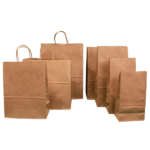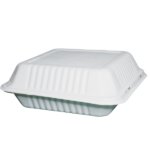Introduction
In recent years, there has been a notable shift in consumer behavior towards more sustainable and eco-friendly choices. This shift is not only evident in the products we buy but extends to the packaging that houses our favorite goods. As environmental consciousness grows, so does the demand for eco-friendly food packaging. In this blog post, we will explore the reasons behind the surge in popularity of sustainable packaging solutions, the impact of such choices on the environment, and how businesses are responding to this growing trend.
The Environmental Wake-Up Call
The environmental challenges facing our planet have become impossible to ignore. From plastic pollution in oceans to overflowing landfills, the consequences of our previous neglect are glaring. Consumers are increasingly aware of the ecological footprint of their daily choices, leading to a collective awakening that extends to the food packaging industry.
1. Plastic Predicament
One of the primary catalysts for the shift towards eco-friendly packaging is the detrimental impact of plastic on the environment. Traditional plastic packaging, often used for food items, takes centuries to decompose, contributing significantly to pollution. Microplastics, a byproduct of plastic degradation, further threaten ecosystems and wildlife. This realization has prompted consumers to seek alternatives that are kinder to the planet.
2. Rising Consumer Awareness
As information becomes more accessible, consumers are educating themselves about the environmental impact of their choices. Social media, documentaries, and educational campaigns have played a pivotal role in raising awareness about the consequences of unsustainable practices. Armed with knowledge, consumers are making conscious decisions to align their values with the products they purchase.
The Benefits of Eco-Friendly Food Packaging
The trend towards eco-friendly food packaging is not just a fleeting fashion; it is grounded in tangible benefits for both consumers and the planet.
1. Reduced Environmental Impact
Eco-friendly packaging materials, such as biodegradable plastics, compostable materials, and recycled paper, have a significantly lower environmental impact compared to their traditional counterparts. These materials break down more easily, reducing the burden on landfills and minimizing pollution.
2. Resource Conservation
Traditional packaging often relies on non-renewable resources, contributing to deforestation and depletion of fossil fuels. Eco-friendly alternatives utilize renewable resources, such as plant-based materials, which helps conserve biodiversity and reduce the strain on finite resources.
3. Brand Loyalty and Reputation
Consumers are increasingly inclined to support businesses that demonstrate a commitment to sustainability. Brands that adopt eco-friendly packaging not only attract environmentally conscious consumers but also build trust and loyalty. In a competitive market, a positive reputation for environmental responsibility can set a brand apart.
Innovations in Eco-Friendly Packaging
The surge in demand for sustainable packaging has spurred innovation within the industry. Manufacturers and businesses are actively seeking and developing new materials and technologies to meet the evolving needs of both consumers and the environment.
1. Biodegradable Plastics
Biodegradable plastics offer a promising alternative to traditional plastics. Derived from renewable resources or designed to break down more easily, these materials decompose faster, reducing the environmental impact associated with traditional plastic packaging.
2. Compostable Packaging
Compostable packaging is designed to be broken down in composting facilities, resulting in nutrient-rich soil. This not only reduces waste but also supports the circular economy by returning valuable nutrients to the earth.
3. Edible Packaging
In a bold move towards sustainability, some companies are exploring edible packaging options. These innovative materials are not only biodegradable but also offer a unique and creative way to minimize waste. Imagine enjoying a snack and then eating the wrapper!
4. Recycled and Upcycled Materials
The use of recycled materials in packaging is becoming more commonplace. From recycled paper to upcycled plastics, incorporating materials with a previous life reduces the demand for new resources and helps close the recycling loop.
Challenges and Obstacles
While the trend towards eco-friendly food packaging is encouraging, it is not without its challenges. Overcoming these obstacles is crucial to ensuring the widespread adoption of sustainable practices within the industry.
1. Cost Considerations
One of the primary challenges faced by businesses transitioning to eco-friendly packaging is the potential increase in production costs. Sustainable materials and processes can be more expensive, making it essential for businesses to find a balance between environmental responsibility and financial viability.
2. Infrastructure and Collection Systems
For certain types of eco-friendly packaging, such as compostable materials, the lack of appropriate infrastructure for collection and processing poses a significant challenge. Without proper facilities, these materials may end up in landfills, defeating the purpose of their eco-friendly design.
3. Consumer Education
While consumer awareness is growing, there is still work to be done in educating the public about the intricacies of eco-friendly packaging. Understanding the differences between various materials and their disposal requirements is crucial for ensuring that consumers actively participate in sustainable practices.
Conclusion
The surge in popularity of eco-friendly food packaging is a positive and necessary step towards a more sustainable future. As consumers become increasingly conscientious about their environmental impact, businesses are responding by adopting innovative and responsible packaging solutions. The benefits, both for the planet and the brands that embrace sustainability, are clear. While challenges exist, continued efforts in research, education, and infrastructure development will help overcome these obstacles and pave the way for a more eco-conscious food packaging industry. As consumers, businesses, and policymakers unite in the pursuit of sustainable practices, the green wave is set to reshape the future of food packaging for the better.







